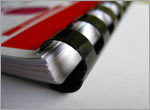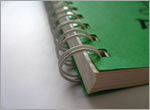Binding
A general term for any of the various methods of securing the loose pages or sections of a book or booklet, binding is usually accomplished using stitching, staples, wire, plastic, tape, or glue, some are more applicable to certain uses, longer or shorter runs and some are more durable than others.
So once your document is printed and ready for binding we would commonly use one of the five methods listed below.
 |
Saddle StitchingSaddle stitching is a method of securing loose printed pages by binding one or more printed sections together, with or without a cover, by means of wire staples through the spine and centre fold, also known as booklet making or staple stitched. This is commonly used for brochures, manuals, annual reports, booklets, newsletters, price lists and catalogues. |
|
 |
Comb BindingComb binding is a method of securing loose printed pages using a piece of plastic with “teeth” that fit into rectangular holes in the paper. It is simple and practical and very similar to wiro binding but uses a plastic comb instead of a wire. This is the most popular method of producing bound documents, especially for office documents and unlike wiro, pages can be added, removed or amended and if big enough the combs can be printed on. |
|
 |
Wiro BindingWiro binding is a sturdier alternative to comb binding and is a way of binding loose leaves using a series of metal wire loops formed from a single continuous wire run through punched holes on the binding edge. They are durable, but do not permit printing on the document spine or the insertion of new pages but the benefit is that all of the document’s pages lie flat when opened and can turn easily through 360 degrees. Wiro is typically used to bind price lists, reference books, note pads, reports, proposals and calendars. |
|
 |
Perfect BindingPerfect binding is a type of un-sewn binding where the leaves of the book are held together at the binding edge by adhesive, a cover is attached to the spine and is formed around the book. It is well suited for use with books, magazines, price lists, brochures and catalogues (minimum thickness of approximately 3mm). |
|
 |
Stab StitchingStab stitching is when you want to secure loose sheets into any of your business form books or pads. To do this, first you collate the loose sheets together, add a grey backboard and top sheet and then they are stab stitched from both sides using two or more very long strong staples and to ensure that the item is secure and presentable we then apply a tape to the spine. This method is used primarily for your NCR pads and books, ie invoices, purchase orders, sales order forms, etc. |
If you require more information please get in touch.












